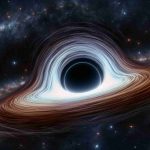Galaxy NGC 5084’s Enigmatic Core Revealed
In a groundbreaking revelation, NASA scientists have uncovered a peculiar phenomenon at the heart of the galaxy NGC 5084. This ancient galaxy, first observed by the renowned astronomer William Herschel, harbors a supermassive black hole that is oriented sideways, defying the standard alignment with its host galaxy.
Utilizing an innovative technique known as SAUNAS, researchers were able to isolate faint X-ray emissions that had previously been overlooked. When analyzing archival data from the Chandra X-ray Observatory, they stumbled upon unexpected X-ray plumes extending from the galaxy’s center. Unlike the single or double plumes typically seen, NGC 5084 boasts four, arranged in an intriguing cross-like pattern.
Further investigation through various telescopes, including the Hubble Space Telescope, illuminated a dusty inner disk rotating at a 90-degree angle compared to the galaxy’s plane. This unusual configuration suggests that NGC 5084’s core has undergone significant disturbances, potentially caused by a clash with another galaxy.
The combined wavelengths of these observations revealed a complex history, as described by the researchers, who likened their findings to gathering evidence from a multi-faceted scene. The implications of this discovery indicate that old data can yield astonishing new insights, hinting at many more enigmatic occurrences yet to be uncovered in the universe. The mysterious structure of NGC 5084 leaves astronomers eager to explore further.
Unlocking the Mysteries of Galaxy NGC 5084: New Discoveries and Implications
Insights into NGC 5084’s Unique Structure
The galaxy NGC 5084 continues to captivate astronomers not only for its peculiar orientation of the supermassive black hole but also for the unique implications surrounding its formation and evolution. As researchers delve deeper into its structure and dynamics, several key aspects emerge that enhance our understanding of galaxy behavior.
Features and Characteristics
1. Supermassive Black Hole Orientation: The sideways alignment of the supermassive black hole challenges existing models of galaxy formation. This orientation may suggest interactions with neighboring galaxies that led to its unusual positioning.
2. X-Ray Emissions: The discovery of the four cross-like X-ray plumes offers valuable information regarding the black hole’s activity and energy output. These emissions are indicators of the environmental processes that occur around supermassive black holes, enhancing our understanding of their growth and interaction with surrounding material.
3. Dusty Inner Disk: The dusty disk rotating at a 90-degree angle implies previous galaxy mergers or interactions. This feature opens avenues for studying how dust and gas transfer between galaxies affects star formation and black hole growth.
Use Cases
These discoveries can lead to:
– Advancements in Astrophysical Models: By revising existing models to accommodate findings from NGC 5084, scientists can better predict the behavior of other galaxies.
– Understanding Galactic Evolution: Insights gained from this research can help explain the pathways through which galaxies evolve, especially in rich galactic environments.
Pros and Cons of NGC 5084 Research
Pros:
– Provides new data for astrophysical research.
– Helps refine theories about galaxy formation and the role of supermassive black holes.
Cons:
– Limited by existing observational technologies; previous data may require re-evaluation.
– Complex interactions make it difficult to form definitive conclusions about galactic behavior.
Controversies and Discussions
The orientation and behavior of the NGC 5084 black hole challenge preconceived notions of supermassive black holes being centrally aligned with their galaxies. This has sparked debates within the astrophysical community regarding the processes that lead to such deviations, particularly concerning how prevalent these phenomena might be in other galaxies.
Market Analysis and Trends
As the field of astronomy becomes increasingly data-driven, the ability to analyze archival data using advanced methods like SAUNAS is paving the way for future observations. The trend towards leveraging existing data for new discoveries signifies a shift in how research priorities are established in astrophysics.
Security Aspects
With improved observational technologies and analysis methods, ensuring the integrity and security of astronomical data has become crucial. Safeguarding this information is essential to maintain its authenticity and reliability for future research.
Predictions for Future Discoveries
As astronomers expand their study of NGC 5084, it is likely that additional anomalies will surface. The discovery of a sideways black hole may suggest that other galaxies could exhibit similar phenomena, prompting further investigation into the mechanics of galaxy interactions.
Conclusion
The revelations surrounding NGC 5084 offer a fascinating glimpse into the complexities of galactic structures and their supermassive black holes. As this research unfolds, it promises to unlock new dimensions of our understanding of the universe.
For more insights into cosmic phenomena and ongoing astronomical research, visit NASA.
















